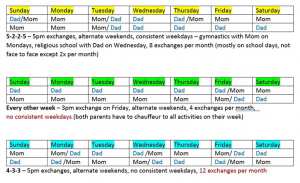The best way to transition to Shared Parenting after separation or divorce is to have been sharing parenting and housework all along – from the day the kids were born. When we establish a new cultural norm that both parents are involved in caring for the children, then the courts have no problem dividing time equally. Some of my clients have been married 2-5 years, some 10-20 years, some never married, and some same sex couples. What they have in common is they share kids whom they love.
When parents split up, the most important thing is that they shift their relationship from an intimate, romantic one to a more business-like relationship with the common goal of raising whole, healthy, happy children. Studies show that it is the intensity and duration of the conflict that is so harmful to children of divorce.
Parents are taking a more active role these days in deciding their parenting plans. Did you know there are many ways to slice’n’dice 50/50 and still call it equal?
Some parenting time schedules are more prone to conflict than others. One day ‘ping pongs’ such as in a typical non-custodial schedule of one night a week and every other weekend are particularly hard on children. Kids need some time to settle in when they go back and forth between one parent’s home and the other.
No one ever said it’s easy for kids to have two homes. Let’s not make it harder with these one day transitions in the schedule. Some parents split the school week with Mon/Tues for one parent and Wed/Thurs for the other and then alternate weekends.
We can learn from what other states are doing. I think Arizona has one of the best guides to appropriate parenting time schedules for different ages and stages of child development. https://www.azcourts.gov/portals/31/parentingTime/PPWguidelines.pdf
Toddlers and preschoolers do better with transitions every few days, school age kids may do well with a 5-2-2-5 schedule, while teens often prefer as few transitions as possible – preferably week on / week off if the parents live close enough to the child’s school to make that possible.
Even a simple change in dropoff time – like Sunday 4pm instead of 6pm can make things go a little easier. With a 6pm dropoff right in the middle of dinner, if the parent dropping off is late, that can create stress all around. 4pm allows a ‘cushion’ so that the transition can go more smoothly. It also gives the child time to settle in so meal time can be a more welcoming, less stressed time.
Some things to consider when deciding on a parenting plan:
1) Can the parents communicate with each other about the kids’ needs without conflict?
2) How close do the parents live to each other – within 5 miles, less than 20 miles, in another city or state?
3) How old are the kids? Toddlers may need different schedules than teens.
4) Where is the children’s school? Are all the children at the same school?
5) Do the parents work outside the home – days/nights/weekends? Does their work involve overnight travel to other cities or states?
6) Do any of the kids have special needs – behavior, learning, dietary, frequent medical care?
Here are some parenting time schedules to consider and some of the pros & cons.
PARENTING TIME EXAMPLES

It’s good to include some language in your decree that says you will revisit your parenting time schedule every 3-5 years as circumstances change – people move, change jobs, get into new relationships, and their kids mature so the schedule they agreed upon years ago may need some updating.
EHTC offers monthly co-parenting workshops. In these workshops we cover communication and conflict resolution skills and there’s plenty of time for talking about real-life co-parenting scenarios with other parents. These groups are ONLINE via Zoom so people can log in from anywhere!
For those who need more support than what is offered in these monthly workshops, parents can purchase individual coaching sessions (packages of 6, 12, or 20 sessions which expire one year from date of purchase).
Hopefully in the classes and coachings, parents gain the communication, conflict resolution, and stress management skills they need for resolving day to day challenges. When facing a bigger issue such as re-arranging a parenting schedule due to a move or job change, finding a care provider to address a child’s health challenge, or seeking help for a child struggling in school, consider mediation – a safe space where the parties are empowered to express what is deep in their hearts, really listen to what the other side is saying, and be open to considering options with a focus on what’s best for the child.
Adina Lebowitz, MA is a family mediator, parenting educator, and wellness  coach.
coach.
Adina’s primary goal is to help families find less stress and more peace in their co-parenting. She supports parents as they are adjusting to a new separation or divorce, and continues to support them as co-parents whether they are facing day to day parenting challenges, or dealing with the impacts of stress on their lives. She is available to mediate bigger issues that impact their parenting plans like a move, job change, new relationship, or a child’s health challenge.
In partnership with the Minnesota Shared Parenting Action Group #MNSPAG she encourages schools, worship congregations, doctors/dentists/therapists, and youth activity & sports directors to communicate schedules & appointments to BOTH parents. Sharing information goes a long way towards reducing conflict and enabling co-parents to find less stress and more peace. #kidsneedboth #doit4MNkids
Elan Health Twin Cities LLC (Minnetonka, MN)
612-499-8418
adina@elanhealthtc.org
www.elanhealthtc.org/mediation




 There has been some buzz about the new film on Netflix called Marriage Story about a couple, Charlie and Nicole, with a son, Henry, going through divorce. I decided to watch it since this is my area of practice and a prospective client referenced it last week in a consultation. It started with the couple stating all these things they loved about the other person with pleasant images of life together. I was ready for an uplifting movie, until about 8 minutes in, when I learn that the couple is in a divorce meditation session and Nicole refuses to read her list out loud of what she loves about Charlie.The mediator says he likes to start mediation with a “note of positivity” to set the stage for working together. Noble idea, but is that the best way to start? I don’t know any mediators that start that way. I wondered if people now think that is how all mediations start. While I too try to start from a more positive place, I start by asking clients to identify the goals they each have for the process and outcomes so we can see if they have any common visions for the future in separate homes. I am amazed how often people have common goals around their kids and other outcomes and many times support goals that are specific to one person. But I don’t think I would start by asking them to share a written list of qualities they love about their soon to be former spouse. That is more appropriate for marriage counseling. What a different dynamic that sets in mediation. When one person wants the divorce and the other one doesn’t, it starts the process from a place of internal conflict. It was visible in the movie. I just don’t think mediators do that and it paints an inaccurate picture of the process.
But, I appreciated how Charlie and Nicole were trying to work together in mediation. Unfortunately, the film spent very little time on the topic of mediation. Instead, at the 20 minute mark, the story moved in the direction of the Nicole, played by Scarlett Johansson, hiring the LA attorney Nora Fanshaw, played by Laura Dern, a sexy, savvy attorney that you want to trust, but your gut tells you, “Not too fast.” When Charlie, played by Adam Driver, goes to find his own attorney, feeling distraught that Nicole suddenly switched directions and hired an attorney, the first attorney he talks to recognizes that Nora is on the other side, clearly knowing how she operates, and says his rate is $900/hr, he needs a retainer of $25,000 and they will need to do forensic accounting for $10,000-$20,000. Everything indicates an expensive, high stakes fight. He then starts asking all these questions to elicit information so he can immediately start strategizing about all these angles to take and “Win!” Charlie realizes what he is walking into, leaves and eventually lands on hiring Bert Spitz at $400/hr, played by Alan Alda, after there is no one else to hire because Nicole has met with all the other “good attorneys” in order to get them disqualified from being able to meet with Charlie. But in the end, reasonable sounding Bert isn’t tough enough against Nora so, Charlie decides to go with the $900/hr attorney afterall.
Well, the whole thing devolves into a knock down drag out court battle over money, custody (including a custody evaluation), and the attorneys revealing every dark secret about the other parent and “slinging mud,” in order to convince the judge to rule in their favor. Your heart breaks for Charlie and Nicole, but especially for Henry, caught in the middle. And then I heard my own voice say, “That is exactly why I am a Collaborative attorney, instead!” It is clear that neither Nicole nor Charlie ever thought they would go down that vicious road but what is clear, is that the divorce took on a life of its own. Nicole left everything to Nora to handle and decided not to question how she operated.
What was also clear to me was who they each chose to represent them had everything to do with how things went. Charlie and Nicole were not asked what was important to each of them or what they wanted for Henry. From the moment they met the attorneys, the attorneys were building their case, setting up the chessboard and thinking about what moves to make to win the game despite the casualties.
Why does that matter? When an attorney can only think in the win-lose mind frame, that they have all the answers and that everything has to follow what they think is the right path, you are giving up all power over your family and your life. Most people I meet with want to be in charge of these major decisions that will impact their life and family. It is important to stop and think about what is important for you, your kids, and your family. You are still part of a family system, even when you are getting a divorce. You are just changing the family configuration, setting new boundaries and expectations, and figuring out how to divide the assets and manage cash flow living separately. Working with attorneys who understand this, who are focused on problem-solving and reaching a win-win outcome out of court, makes all the difference for clients and their family. And if you have two attorneys who trust each other professionally, that is an asset to you and your spouse. The Collaborative Divorce process offers just that: a respectful, transparent, child-focused, problem-solving out-of-court approach for divorce. Ask yourself what story you want your children to say about their parents’ divorce when they are 25? Choose wisely.
There has been some buzz about the new film on Netflix called Marriage Story about a couple, Charlie and Nicole, with a son, Henry, going through divorce. I decided to watch it since this is my area of practice and a prospective client referenced it last week in a consultation. It started with the couple stating all these things they loved about the other person with pleasant images of life together. I was ready for an uplifting movie, until about 8 minutes in, when I learn that the couple is in a divorce meditation session and Nicole refuses to read her list out loud of what she loves about Charlie.The mediator says he likes to start mediation with a “note of positivity” to set the stage for working together. Noble idea, but is that the best way to start? I don’t know any mediators that start that way. I wondered if people now think that is how all mediations start. While I too try to start from a more positive place, I start by asking clients to identify the goals they each have for the process and outcomes so we can see if they have any common visions for the future in separate homes. I am amazed how often people have common goals around their kids and other outcomes and many times support goals that are specific to one person. But I don’t think I would start by asking them to share a written list of qualities they love about their soon to be former spouse. That is more appropriate for marriage counseling. What a different dynamic that sets in mediation. When one person wants the divorce and the other one doesn’t, it starts the process from a place of internal conflict. It was visible in the movie. I just don’t think mediators do that and it paints an inaccurate picture of the process.
But, I appreciated how Charlie and Nicole were trying to work together in mediation. Unfortunately, the film spent very little time on the topic of mediation. Instead, at the 20 minute mark, the story moved in the direction of the Nicole, played by Scarlett Johansson, hiring the LA attorney Nora Fanshaw, played by Laura Dern, a sexy, savvy attorney that you want to trust, but your gut tells you, “Not too fast.” When Charlie, played by Adam Driver, goes to find his own attorney, feeling distraught that Nicole suddenly switched directions and hired an attorney, the first attorney he talks to recognizes that Nora is on the other side, clearly knowing how she operates, and says his rate is $900/hr, he needs a retainer of $25,000 and they will need to do forensic accounting for $10,000-$20,000. Everything indicates an expensive, high stakes fight. He then starts asking all these questions to elicit information so he can immediately start strategizing about all these angles to take and “Win!” Charlie realizes what he is walking into, leaves and eventually lands on hiring Bert Spitz at $400/hr, played by Alan Alda, after there is no one else to hire because Nicole has met with all the other “good attorneys” in order to get them disqualified from being able to meet with Charlie. But in the end, reasonable sounding Bert isn’t tough enough against Nora so, Charlie decides to go with the $900/hr attorney afterall.
Well, the whole thing devolves into a knock down drag out court battle over money, custody (including a custody evaluation), and the attorneys revealing every dark secret about the other parent and “slinging mud,” in order to convince the judge to rule in their favor. Your heart breaks for Charlie and Nicole, but especially for Henry, caught in the middle. And then I heard my own voice say, “That is exactly why I am a Collaborative attorney, instead!” It is clear that neither Nicole nor Charlie ever thought they would go down that vicious road but what is clear, is that the divorce took on a life of its own. Nicole left everything to Nora to handle and decided not to question how she operated.
What was also clear to me was who they each chose to represent them had everything to do with how things went. Charlie and Nicole were not asked what was important to each of them or what they wanted for Henry. From the moment they met the attorneys, the attorneys were building their case, setting up the chessboard and thinking about what moves to make to win the game despite the casualties.
Why does that matter? When an attorney can only think in the win-lose mind frame, that they have all the answers and that everything has to follow what they think is the right path, you are giving up all power over your family and your life. Most people I meet with want to be in charge of these major decisions that will impact their life and family. It is important to stop and think about what is important for you, your kids, and your family. You are still part of a family system, even when you are getting a divorce. You are just changing the family configuration, setting new boundaries and expectations, and figuring out how to divide the assets and manage cash flow living separately. Working with attorneys who understand this, who are focused on problem-solving and reaching a win-win outcome out of court, makes all the difference for clients and their family. And if you have two attorneys who trust each other professionally, that is an asset to you and your spouse. The Collaborative Divorce process offers just that: a respectful, transparent, child-focused, problem-solving out-of-court approach for divorce. Ask yourself what story you want your children to say about their parents’ divorce when they are 25? Choose wisely.




